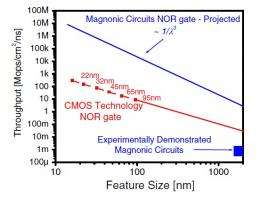June 28, 2010 feature
Researchers analyze the future of transistor-less magnonic logic circuits

(PhysOrg.com) -- As one of the newest research areas today, the field of magnonics is attracting researchers for many reasons, not the least being its possible role in the development of transistor-less logic circuits. Information presented at the first conference on magnonics last summer in Dresden has spurred a cluster of papers that focus on the recent progress in the field. In one of these studies, Alexander Khitun, Mingqiang Bao, and Kang L. Wang from the University of California at Los Angeles have shown that magnonic logic circuits could offer some significant advantages - in spite of some disadvantages - that may allow them to not only compete with but also outperform transistor-based CMOS logic circuits.
The field of magnonics gets its name from spin waves and their associated quasi-particles called magnons, which have attracted scientific interest since the 1950s. Spin waves can generate collective spin excitations in magnetically ordered materials; by controlling the surrounding magnetic field, researchers can also control spin excitations and use them, for example, to carry and process information.
Over the past few years, researchers have been investigating how to exploit spin wave phenomena to make logic circuits, which are the basis of data processing in electronic devices. Whereas CMOS logic circuits use electric current to store and transfer data, magnonic logic circuits use spin waves propagating in magnetic waveguides. By avoiding electric currents, magnonic logic circuits have the potential to enable more efficient data transfer and enhanced logic functionality, including parallel data processing.
On the other hand, spin waves are known to have properties that present disadvantages for data processing, which include having a group velocity that is more than 100 times slower than the speed of light, and an attenuation (reduction of signal strength) that is more than 1,000,000 times higher than for photons. However, as chip density has increased and the distances between components have become smaller, the slow velocity and high attenuation have become less problematic. Now, fast signal modulation has become more important, which spin waves can provide due to their short wavelength and long coherence length.
As the researchers explain in their analysis, a magnonic logic circuit can encode a bit of information in two ways: through either the amplitude or the phase of the spin wave. In the first working spin wave-based logic device demonstrated in 2005, Mikhail Kostylev and coauthors used the amplitude-encoding approach. They split the spin wave into two paths, which would later interfere with each other either constructively or destructively. The interference creates two opposite amplitudes that represent the 0 and 1 logic states. In the second approach, a spin wave propagating through an inverter waveguide undergoes a half-wavelength phase change. The original phase '0' and the inverted phase 'π' can then be used to represent the logic states 0 and 1, respectively.
While the amplitude-encoding approach has benefits including low power consumption due to the low energy of the spin wave signal, the researchers here think that the phase-encoding approach is more promising. This is because the phase-encoding approach enables different frequencies to be used as separate information channels, allowing parallel data processing in the same device. The capability of multi-channel data processing would provide a fundamental advantage over existing switch-based logic circuitry, and could lead to performance rates beyond the limits of today’s technology.
“The greatest potential advantage of magnonic logic circuits is the ability to process information in parallel on different frequencies, which is not possible for CMOS-based logic,” Khitun told PhysOrg.com.
Khitun, Bao, and Wang have previously fabricated a prototype magnonic device that operates in the GHz frequency range and at room temperature. However, in order for magnonic logic circuits to take advantage of their potential benefits, researchers will have to find solutions to several challenges. For instance, current prototypes will require increased energy efficiency and will need to be scaled down to the submicrometer range in order to compete with CMOS logic circuits. In comparison, there is still plenty of room to scale down the size of transistors, although power dissipation will likely make further scaling inefficient in the CMOS architecture.
Another challenge for the magnonic phase-encoding approach in particular is the requirement for a bi-stable phase element to provide the output on two phases. In their analysis, the researchers note that one candidate is a device called the magnetic parametron, which was invented in the early days of magnetic computers more than 50 years ago. Interestingly, the parametron-based magnetic computers originally competed with transistor-based computers, which eventually proved to be the better option. Yet the magnetic parametron may now provide magnonic logic circuits the ability to live up to their potential.
Other challenges for magnonic logic circuits include minimizing the inductive crosstalk between input and output ports, demonstrating some components of the circuits that have not yet been realized, and ensuring that the spin wave devices are compatible with conventional electron-based devices to enable efficient data exchange.
Although the development of high-performance magnonic logic circuits will face challenges, Khitun, Bao, and Wang conclude that the advantages are significant enough to justify extensive research. Overall, the researchers predict that, even if the magnonic logic circuits don’t fully replace CMOS logic circuits, they may provide complementary components by offering low-power-consuming hardware for certain general and special task data processing.
More information: Alexander Khitun, Mingqiang Bao, and Kang L. Wang. “Magnonic logic circuits.” J. Phys. D: Appl. Phys. 43 (2010) 264005 (10pp). doi:10.1088/0022-3727/43/26/264005
Copyright 2010 PhysOrg.com.
All rights reserved. This material may not be published, broadcast, rewritten or redistributed in whole or part without the express written permission of PhysOrg.com.


















